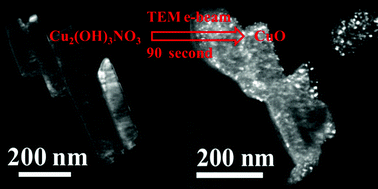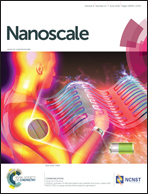Electron-beam irradiation induced transformation of Cu2(OH)3NO3 nanoflakes into nanocrystalline CuO†
Abstract
The transmission electron microscope electron-beam (TEM e-beam) as a material modification tool has been demonstrated. The material modification is realised in the high-resolution TEM mode (largest condenser aperture, 150 μm, and 200 nm spot size) at a 200 keV beam energy. The Cu2(OH)3NO3 (CHN) nanoflakes used in this study were microwave solution processed that were layered single crystals and radiation sensitive. The single domain CHN flakes disintegrate into a large number of individual CuO crystallites within a 90 s span of time. The sequential bright-field, dark-field, and selected area electron diffraction modes were employed to record the evolved morphology, microstructural changes, and structural transformation that validate CHN modification. High-resolution transmission electron microscopy imaging of e-beam irradiated regions unambiguously supports the growth of CuO nanoparticles (11.8(3.2) nm in diameter). This study demonstrates e-beam irradiation induced CHN depletion, subsequent nucleation and growth of nanocrystalline CuO regions well embedded in the parent burnt porous matrix which can be useful for miniaturized sensing applications. NaBH4 induced room temperature reduction of CHN to elemental Cu and its printability on paper was also demonstrated.


 Please wait while we load your content...
Please wait while we load your content...